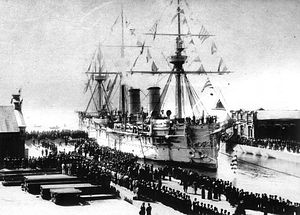In early July, many international media outlets flocked to report a fascinating story about a Russian warship wreck containing $130 billion in gold “treasure” that had reportedly been discovered by a South Korean company on the seabed off a South Korean island.
Shinil Group, which was only established in June, claimed it had discovered the wreck of the Dmitrii Donskoi, a Russian armored cruiser built in the 1880s and sunk in 1905 after a battle with Japanese warships.
The company added that the ship held about $130 billion in gold and claimed that it was the “only entity in the world” to have discovered the ship.
Its announcement was accompanied by photos and video of a wreck, including a section that appeared to show the ship’s name. It said the search team included experts from Britain, Canada, and South Korea.
The story, which appeared to fascinate people outside South Korea, is in fact not new at all to South Koreans. Shinil Group is not the first to have claimed the discovery of this Russian ship containing “treasure.”
The Dmitrii Donskoi has been a popular topic among the South Korean public for years, especially among investors hungrily seeking instant fortunes. The search for the sunken ship goes back nearly 40 years.
In 1981, a company by the name of Dojin Industrial launched a search for the Donskoi by obtaining a permit to excavate a buried object, but failed to find any trace of the fabled vessel.
In August 1999, DongA Construction began a search for the vessel. The treasure-seeking campaign took place right after the financial crisis in South Korea, at a time when the gold market reached very high levels. It was a good opportunity for DongA Construction to make a start on growing the business.
DongA Construction’s stock price soared as the news of the treasure ship exploration was widely reported. From December 15, 2000, to January 4, 2000, its stock prices rose for 17 consecutive days. However, DongA Construction was declared bankrupt in June 2001 and was delisted after they failed to discover the vessel.
DongA Construction finally did discover a vessel, which the company believed was the Donskoi, but it failed to raise it due to objections from creditors. At that time, DongA Construction estimated that the vessel was carrying $220 billion in gold.
Every time someone claims the discovery of a treasure ship, South Korea reacts in the same way. Its stock market takes the lead. So-called treasure ship-theme equities start to see their prices rising. They often include companies affiliated or related in any way to the discoverer.
It was no different this time. One of the most popular trending keywords on South Korea’s largest internet portal website last month was “treasure ship-theme equities.” People flocked to buy such equities, thus the stock market fluctuated.
It is a bit discouraging to see the market fluctuate so dramatically with these wild rumors in a country with a mature stock market that has witnessed steady growth and is believed to be as advanced as other leading economies around the world.
However, this edition of the Donskoi scandal shows positive signs for South Korea’s stock market in two ways.
It is a strong signal that the end of the bull market rally, which began last year, is in sight. It is common to see many kinds of speculative investment behavior at the end of a bull market, and the attention generated by the treasure ship is likely proof of this.
The South Korean stock market has witnessed sudden rises in recent months amid signs of improving inter-Korean relations. Companies that are expected to benefit from the improved relations have seen an increase in their stock prices. Many have been wondering when it would end, and the attention around Donskoi could be signaling such an end.
The scandal has also proven that reckless rumors do not work in the stock market in the wake of the fourth industrial revolution. In the past, DongA Construction saw its stock price rising for 17 consecutive days based just on a claim that it had discovered the ship. It took a long time for the public to verify the necessary information; even government authorities were no exception. A lack of information and unverified rumors all contributed to the turmoil of the stock market at that time.
This time, however, people were able to find the necessary information online within a few hours, and people had the time to judge the situation and react accordingly. The authorities were also able to respond almost immediately, and the stock market has stabilized relatively quickly.
Some information provided by Shinil Group has been found to be false, but the company is still claiming that the existence of the vessel is genuine while seeking investors.
Time will reveal whether the company’s claim is true, but at least it has proved the maturity of the South Korean investors. Clearly some lessons have been learned from previous cases.

































